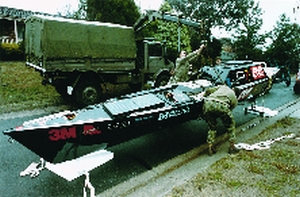
On December 13, 1996, Stuart Andrew became the first person to cross the Bass Straight alone in a pedal boat. On completing this goal he remarked, “I’d never do it again. I’d never think of doing it again. My legs feel like big lumps of wood, my eyes are stinging, but I’ve finally made it.” The following article was published by Epoxyworks in Fall 1996, a few months before Andrews made his record breaking journey in a 7.45 meter pedal boat constructed of Durakore® and WEST SYSTEM® Epoxy.
By Stuart Andrews
I have undertaken a number of endurance-based adventure activities that laid the foundation for my most recent adventure, taking a pedal-powered boat from Australia to Tasmania. While investigating the logistics of this trip, I realized the Bass Strait is probably one of the most hazardous in the world.
I have spent the past two years chasing sponsors and working with naval architects and engineers. We’ve designed an ocean going craft that will handle the roughest conditions. The long hours I’ve put into this project have been physically and mentally draining. But it is a nice feeling to lift that garage door and see a sleek bodied boat, all fitted out and ready to take me on an adventure of a lifetime. I have always dreamed of undertaking a major solo crossing. To achieve this under my own power will be close to being the ultimate challenge for me.
The boat is fully self-righting and pedal powered, 7.45m (24′ 5″) long and 1.45m (4′ 9″) wide. We built it of fiberglass and carbon using Baltec DuraKore strip planking system and WEST SYSTEM Epoxy, provided by ATL Composites in Queensland. Basing our design around this construction process resulted in a very light weight and exceptionally strong craft. The boat weighs just 650 kg (1433 lb) fully stocked with me aboard.
Recent trials indicate the boat meets our design criteria and can maintain a cruising speed of approximately 4 knots. Jac Free (Free Enterprises, USA) designed the propeller. It is an extremely efficient 510mm (20-inch) two-blade carbon propeller that lets me reduce power when I need to maneuver the boat.
The boat has two Global Positioning Systems, a Survivor 35® desalinator, Codan® HF radio with a Moonraker® aerial system, Hewlett-Packard® Omni 600 computer. The bedding is made up from Gore-Tex® as is my dry suit. The Department of Defense is supplying most of my food, which is a specially formulated freeze dried cuisine.
In 1994, I rode a specially designed recumbent bike (reclining position) from Perth to Canberra, covering 5260 km (3268 miles) in 24 days. This simulated the physiological stress on my body during the Tasman crossing. The boat has a recumbent peddling mechanism. It is efficient and keeps my center of gravity low.
I have been working closely with ISOSPORT, the major sponsors of the Bass crossing. Their scientific and financial support has gone a long way toward bringing this crossing close to reality.
We have tested the boat in various sea conditions, but with the unpredictable weather patterns in the Bass Strait, it is difficult to determine how long the trip will take. I’m sure however long it takes, I will have plenty of time to think about the next adventure to chase
Editors note—Stuart had the backing of the Australian Defense Force and the Australian Institute of Sport. He represented Australia internationally for many years in both Summer and Winter sports, including the Olympic games. He is a former national decathlon champion and was a member of Australia’s World Cup bobsleigh team in 1992.





